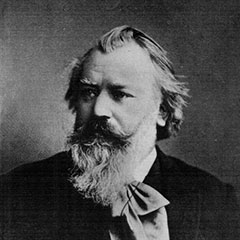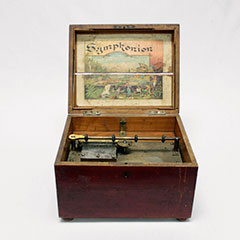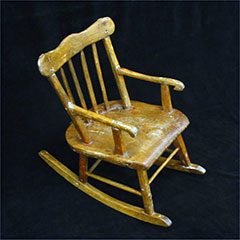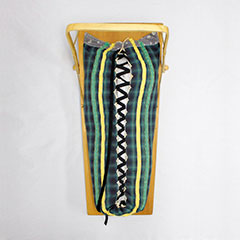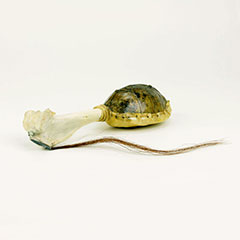The Lullaby
Whether they are sung or hummed, lullabies are designed to soothe children or put them to sleep. Lullabies exist in every culture, in different forms. They are sometimes derived from childish tunes, popular songs, or classical pieces. It is the first melody intended for newborns, to comfort and appease them. It is proven that singing has a positive influence on the amount of crying, a child’s level of wakefulness, his emotional attachment, and his overall well-being.
A simple structure and repetitive patterns are typical of lullabies. Recurring phrases, words and syllables, as well as a play on sounds, add to the musicality of such pieces. It is not uncommon to hear foreign or archaic words, or even baby talk, in these songs.
Many lullabies are included in Québec’s popular song repertoire today. Most have spanned over more than one generation. Trois petits chats (Three little cats), Au clair de la lune (In the moonlight), Frère Jacques (Brother Jacques), Meunier tu dors (Miller, you are asleep), Chère Élise (Dear Élise), La Souris verte (The green mouse), À la claire fontaine (To the clear fountain) are among the songs parents croon to soothe their child.
The Little Gray Hen
Download audio (1 minute 19 seconds, 1.22 MB)
Female voice (Hélène Baillargeon) interprets the children's nursery rhyme The Little Gray Hen, accompanied by a guitar.
Composer: Québec folk song
Performer: Hélène Baillargeon, 1958
Source: Grande Bibliothèque, level 4, nation. coll., music, conservation. Classification: D000012173 CON
That laid in the church,
She will lay a lovely egg
For little [child's name] who is going to sleep
Beddy-bye.
She will lay a lovely egg
For little [child's name] who is going to sleep
Beddy-bye and to sleep.
There is the little brown hen,
That laid on the moon…
She will lay a lovely egg
For little [child's name] who is going to sleep
Beddy-bye.
She will lay a lovely egg
For little [child's name] who is going to sleep
Beddy-bye and to sleep.
Music box
Music box melodies are frequently cradle songs. This mechanical instrument has a soft sound and a soothing effect, so it is often used to lull babies to sleep.
Music Box
Download audio (16 seconds, 0.25 MB)
Music from a child’s music box. We hear a lullaby.
Source: Free sound bank
Most music boxes and mobiles created for children spout the same melody: a German composition called Good evening, good night (Guten Abend, Gute Nacht) but more widely known as "Brahms’ Lullaby". It is undoubtedly one of the world’s most famous lullabies, thanks to its widespread use in the toy industry. Composed in 1868 by Johannes Brahms for the piano, Good evening, good night is part of a group of five lieder. It is believed that Brahms’ inspiration was a melody sung by a childhood friend of his, Bertha Faber. It was actually performed for the first time by Mrs. Faber on her son’s Hans’ birthday. The lullaby’s first stanza is pulled from a compilation of popular German songs titled The Child’s Wonderful Horn (Des Knaben Wunderhorn). The second stanza was written by Georg Scherer in 1849.
Original German Version
Guten Abend, gute Nacht
mit Rosen bedacht
mit Näglein besteckt
schlupf’ unter die Deck!
Morgen früh, wenns Gott will
wirst du wieder geweckt
Guten Abend, gute Nacht
von Englein bewacht
die zeigen im Traum
dir Christkindleins Baum
Schlaf nun selig und süß
schau im Traum’s Paradies
Guten Abend, Gute Nacht (Good Evening, Good Night)
Download audio (1 minute 54 seconds, 1.69 MB)
Wiegenlied (Lullaby) composed by Johannes Brahms, performed by Ernestine Schumann-Heink (1861-1936) in 1915.
Composer: Johannes Brahms
Performer: Ernestine Schumann-Heink, 1915
Source: Wikipedia
with roses bedight,
with lilies o'er spread
is baby's wee bed.
Lay thee down now and rest,
may thy slumber be blessed.
Lullaby and good night,
thy mother's delight,
bright angels beside my darling abide.
They will guard thee at rest,
thou shalt wake on my breast.
English Version
Many version of this song exist. Such variety can be explained by the fact that the original German song was translated in many languages.
Good evening, good night
Watched over by roses
Covered in tiny thorns
Slip under the quilt
Tomorrow morning, God willing
You will awaken again
Good evening, good night
Watched over by cherubs
Who show you in your dreams
Baby Jesus’s tree
Sleep only, blissfully and softly
Look into Heaven’s dreams
Bonsoir, bonne nuit (Good Evening, Good Night), French version
Download audio (1 minute 50 seconds, 1.75 MB)
Lullaby composed by Johannes Brahms, performed by Rosemonde Gérard in 1948.
Composer: Johannes Brahms
Performer: Rosemonde Gérard, 1948
Source: BAnQ – digital collection [sound recordings]
Sleep cheerfully, dreaming of heaven
When morning comes, you will awaken
When morning comes, you will awaken
Good night dear treasure, dream of white angels,
Your brothers in heaven, God’s friends
Close to you, your mother will tenderly guard
Close to you, your mother will tenderly guard
Amerindian lullabies
For the First Nations, a child learns about his people’s mythology thanks to the oral tradition, with songs being an important part of this transmission method. Young ones become aware of their origins, of their tribe’s beliefs and customs. Simple musical genres like lullabies and nursery rhymes have crossed generations.
Often very simple, intoned on two or three repetitive notes, they were untouched by the passing of time. They were also preserved because they did not clash with European culture or Christian religion.
The lullaby titled OHKWÁ :RI TENHANÓNNIAHKWE (The bear will dance) comes from the Mohawk tribe. The bear represents one of the three matrilineal clans of this nation, the others being the wolf and turtle clans. This lullaby’s melody should be repeated many times, until the child falls asleep.
TOHSA’ SEKSÁ :A TESASHÉNTHO
OHKWÁ :RI TÁ :RE TENHANÓNNIAHKWE
OHKWÁ :RI TÁ :RE TENHANÓNNIAHKWE
Translation
Dry your tears, child
The bear will dance for you
The bear will dance for you
The Atikamek nation has a lullaby called NIKAMUNISS. This song’s rhythm gives it a hypnotic quality, evoking a rocking motion. The melody is extremely simple, consisting of only one word "bao", which means sleep, repeated over and over again. In fact, the repetition of syllables is the main characteristic of Amerindian songs.
Even though their topics are not directly related to young children, some Aboriginal songs are also used as lullabies. This is the case with “Odanak’s Song,” composed in the Abenaki language by Ambroise O'Bomsawin in 1960.
Odanak Song. Author: Ambroise O’Bomsawin, circa 1960
Download audio (1 minute 41 seconds, 2.31 MB)
Native American song chanted by children and adults according to tradition, without musical instrument.
Source: Musée des Abénakis. Recordings of the Aw8ssisak Akik singing band, 2012.
(Unofficial English translation)
Odanak, my beautiful village,
You whom I love more than anything in the world,
Precious heritage of our fathers
I will never leave you
Odanak, heart of my life
Love this hamlet full of life
Settle your home on a new ground
Invite your Abenaki brother
To sit next to you
To share your happiness
The forest envelops your morning
Stones sleep there peacefully
May such a fate does not befall Odanak
Be watchful
Your happiness is the price
In addition to music and songs, rhythmic movements also bring comfort to toddlers. Rocking chairs and baby carriers exert a calming effect on babies by providing a sense of security and well-being. Some gentle and harmonious sounds are also beneficial for the child. Historically, toys that produce sounds, such as rattles, have generated tranquillity, fun and child cognitive development.

